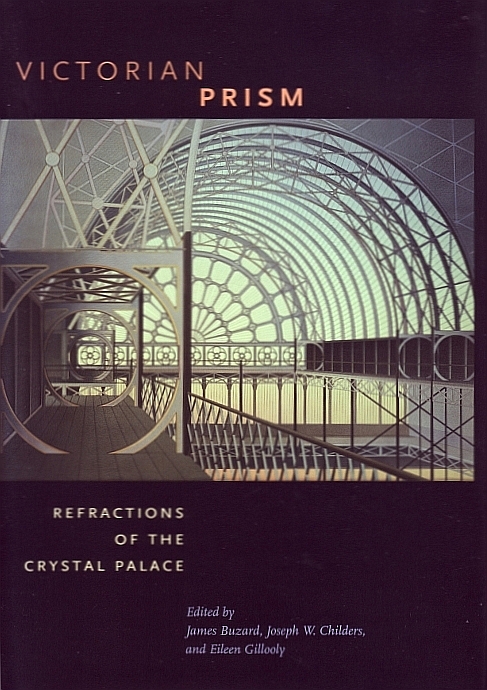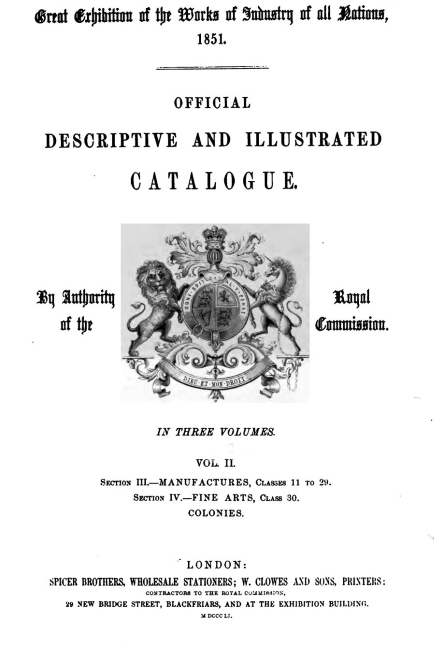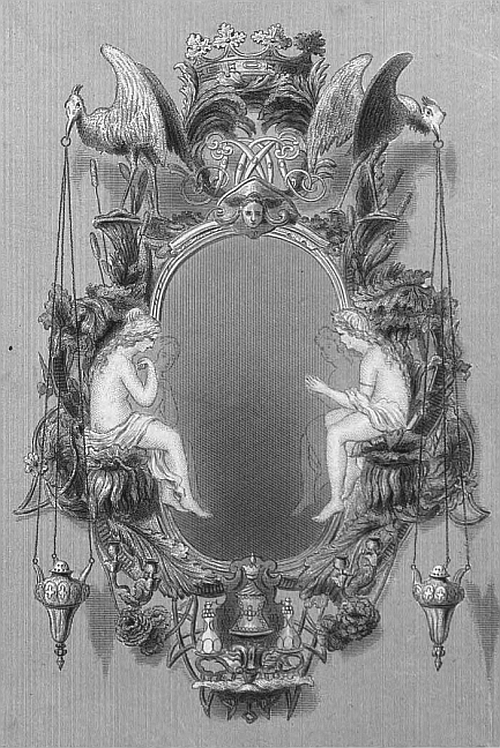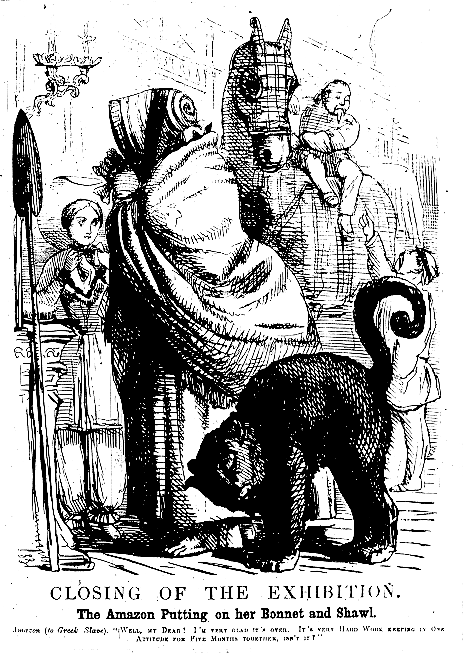All images, apart from the first, come from the Victorian Web or the Internet Archive. You may use these images without prior permission for any scholarly or educational purpose as long as you (1) credit the source and (2) link your document to this URL in a web document or to the Victorian Web in a print document. [Click on all the images to enlarge them, and for more details where available.]


Left: Front jacket of the book under review, showing Ben Johnson's Crystal Palace Reconstruction, acrylic on canvas, 1984. Right: The Crystal Palace in Hyde Park. Source: Dickinson, frontispiece.
The 150th anniversary of the Great Exhibition of 1851 did not pass unnoticed. A series of conferences was held to celebrate it and to re-examine the event's significance and its complex impact on the modern and indeed the postmodern consciousness. As the editors of Victorian Prism explain in their introduction, the present book is a collection of revisionist essays from these conferences. The sixteen contributors (who include the editors themselves) are neither concerned with the history of the Crystal Palace as such, nor with ideological interpretations of what it stood for; rather, they aim to go beyond the "dominant Victorian accounts" of it (3), beyond even the more recent "one-note treatments" of it by politically committed critics (7), and demonstrate the many different meanings to be found in it. We are invited to understand it for what is really was: an irreducibly multi-faceted phenomenon. The analogy in the title is a useful one: seen like this, the Crystal Palace loses none of its sparkle, but sends rays of light further afield, into the darker corners of its age, and forward too, towards the complexities of our own.
Catalogue and Floor Plan
The majority of the contributors are professors of English; predictably, then, Part One ("Exhibitionary Aims and Anxieties") opens with an analysis of the official catalogue itself. In an essay entitled "Rhetorical Remedies for Taxanomic Troubles," Eileen Gillooly immediately turns our preconceptions on their heads, using the tools of modern critical analysis to expose behind the text's "simple allegory of progress, a counter-narrative of anxious competition, fear, denial, envy, and revenge" (36). The prominence given to the Indian exhibits, for example, is seen as an attempt to boost British standing by associating Britain with the fount of Indo-European civilisation, and, of course, with the resources available in the sub-continent. Beneath the surface of the catalogue lies an uncomfortable awareness of this strategy. After all, the "Hindoos" themselves had not been able to capitalise on their raw materials and fine craftsmanship. What could be done, except (through the East India Company) to exploit the former and compete with the latter — even in the Indian market-place? The apparently confident text turns out to be a form of self-justification, and thus a rich source of hidden uncertainties, both about the host country's relations with other countries, and about its own cultural and even moral status.



Left to right: (a) Title page of Official descriptive and illustrated catalogue, Vol. II. Indian muslin is discussed in equivocal terms in this volume (see p. 484). (b) The Indian pavilion. (c) A group of Indian artworks displayed there.
In the next essay, "Conflicting Cartographies," James Buzard investigates not the catalogue but the spatial arrangement of the exhibits, which entirely subverted Prince Albert 's proposal that "grouping [of items displayed] be without reference to national origin" (45). In the event, and despite opposition, the nationality of the exhibitor became as important as the quality of the exhibit. It is hard to make much of the floor plans reproduced in the middle of the book, because the print, sometimes against dark backgrounds, is so tiny; but we are told that a geographical layout gave Britain and its colonies half the available space. Here was an outcome that again served the imperial project and betrayed an underlying insecurity — another pointer, as Buzard suggests, to the cultural fragmentation lying ahead.
Ways of Looking
In Part Two ("Exhibition Viewing"), the focus turns to the visual, but the approach is similar: to probe beneath the surface for new narratives, and for signs of instability. Isobel Armstrong's ingenious "Languages of Glass" sets the pace. It homes in on a highly ornamental "Grand Boudoir-Glass" by William Potts of Birmingham, with porcelain nymphs seated either side of a heavy brass frame and gazing at themselves in the water/glass, in which their reflections are lightly etched. Armstrong shows how the general trickiness of glass as a medium is multiplied by the juxtaposition of reflections, and of the glass itself with other materials. Again, there is a telling deconstruction, this time of an account by a contemporary journalist. Even though this journalist is writing for the radical Reynolds's Weekly News, he either misses or chooses to miss the mirror's more ominous implications, seen for example in its imperfectly embossed Latin motto (one possible English version of which would be, "I may be broken, but I will not bend"), and writes glowingly about it. In Armstrong's twenty-first century reading, however, the extravagant but fragile ornament hints at the intransigent Victorian aristocracy, and the danger of violent confrontation with it. More generally, like the other contributors, Armstrong alerts us to the ultimately hopeless endeavour of definitive seeing, especially in such a decontextualized space.



Left to right: (a) "Mirror Frame in Bronze. W. Potts. Birmingham." Source: Tallis's History and Description of the Crystal Palace, Vol. II. Engraved by O. Greatbach from a Daguerreotype, following p.202; note that the engraving does not show the motto found at the top of the glass, as seen in the official catalogue. (b) Mocking the prudery of some visitors, Punch shows hitherto nude statues all dressed up and ready to go at the end of the exhibition. (c) "Welcome!" Punch on the opening of the National Portrait Gallery, with Britannia shepherding in the likenesses of her worthiest subjects.
One of the strengths of these essays, by contributors who are mainly literary critics, is the great range of contemporary sources on which they draw. Prominent amongst these is John Ruskin, whose hatred of the exhibition, and horror of mechanically generated work, proved to be so profoundly influential. But Rachel Teukolsky, in an essay that follows on smoothly from Armstrong's, reminds us of the extent to which his "moral, socially conscious vision of art" went "against the grain" of his own time (85). In "This Sublime Museum: Looking at Art at the Great Exhibition," Teukolsky identifies the variety of other ways in which art was being "read" by Ruskin's contemporaries, sometimes already with a more professional detachment — and, especially in this setting, as a commodity. Nude sculpture was a testing-ground here, inevitably eliciting different responses from observers with different agendas, and giving cause for more anxiety: might it not provoke embarrassment or ribaldry in those with untrained eyes? Prudish attitudes were mercilessly ridiculed in Punch. Most welcome in Teukolsky's essay is her playing down of the "Battle of the Styles," which obscures so much else that was happening in both design and architecture at this time (see p. 97). Eclecticism, as the exhibits themselves made abundantly clear, was not just a late Victorian development.
Different theories of art are further explored in the next essay, "National Portraits," by Richard L. Stein. This is a particularly useful discussion of "one of the Great Exhibition's most important contemporary institutions" (101), the National Portrait Gallery. With Carlyle as one of its earliest trustees, this was meant to encourage and feed the appetite for hero-worship, displaying works less for their aesthetic value than for the potential to mould the national character. It seemed to work: the first secretary of the NPG, George Scharf, was delighted to see "even charity children" flocking to see the NPG's founding gift, the Chandos Shakespeare (111).
The Lower Orders



Punch cartoons by John Leech from Memorials of the Exhibition — 1851. Left to right: (a) "Britannia has the Industry of all-the-world-and-his-wife to spend a few months with her." (b) Dinner time at the Crystal Palace. (c) Shilling Day visitors are disappointed to be offered strawberries and wafers (refined) instead of beer (vulgar) in the Refreshment Room.
Yet the "national character" was not so malleable. Returning to the Great Exhibition itself, Part III of Victorian Prism is entitled "Exhibiting Publics," and it is less sanguine about the dissemination of cultural values. The first essay, by Karen Chase and Michael Levenson, has an ominous title: "Mayhew, the Prince, and the Poor: The Great Exhibition of Power and Dispossession," and undercuts Henry Mayhew's comic novel 1851 with more revealing excerpts from his own London Labour and the London Poor. Questions are also raised in social historian Peter Gurney's "A Palace for the People?" The fact is that even "Shilling Days" at the Crystal Palace were beyond many people's means. Moreover, high-minded aims of edifying and inspiring the lower orders went hand in hand with concerns about keeping them under control. Resisting all types of social engineering, the lower orders in turn could be.disobligingly unpredictable. They were apt to ignore or vulgarise what was on display. George Gissing's Nether World (1889) shows how completely they could succumb to the seductions of consumerism in a new age of cheap reproducibility. Gurney warns us against being condescending and simplistic, though, suggesting that the palace was "a battleground where Victorian consumer culture was debated and fought over, a site where different consumption practices and ideologies intersected and clashed" (139-40). It is strange to think that the outcome was not, at that time, a foregone conclusion.
By the end of its life on Sydenham Hill, Joseph Paxton's great glasshouse had taken on aspects not only of the market-place, but of theme-park, concert-hall, events-space and even sports arena. Prince Albert, who had set out to parade and foster "the industry of nations," could not have foreseen that his brainchild would eventually become a venue for pet shows. Perhaps this was inevitable. Andrea Hibbard's concluding essay in this section, "Distracting Impressions and Rational Recreation at the Great Exhibition," suggests that the Crystal Palace was not just an amazing spectacle, it was a bewildering one as well. It seems to have produced something of the same information and sensory overload as the one to which our own age is subject. The result was to make the improving use of leisure time harder rather than easier; the whole philosophy of "Rational Recreation" is called into question here. It would have been interesting to see some comparisons in this section with other "People's Palaces" like Alexandra Palace in Muswell Hill, and The People's Palace in Glasgow — both of which are still with us today.
Nations on Display



Left to right: (a) The Greek Slave, by Hiram Powers (1844). (b) The United States pavilion, watched over by its pasteboard eagle. The Greek Slave is on a pedestal under a red canopy, with a little knot of people in front of it. The Wounded Indian, to the left of this tableau, cannot be made out here (Dickinson, subject 25). (c) The Wounded Indian, engraved by Hollis, from a daguerreotype by Beard. Source: Tallis, following p. 226.
The teasing strategy of opening up rather than resolving issues continues on a grand scale in Part IV, "Others on Exhibit," which widens the focus by dealing with how various countries represented themselves at the Hyde Park site, or in events spawned by it; and how a couple of journal-writing colonial visitors saw and were seen by their hosts. Tables continue to be turned; the scope for layered reading is immense. Kate Flint's "Exhibiting America," for example, considers the surprisingly empty space of the American Court at the Great Exhibition, and the equally surprising decision to people it, at least partially, with two troubling sculptures, Hiram Powers's The Greek Slave (1844), and Peter Stephenson's The Wounded American Indian (1848-50). As Teukolsky has already pointed out, most art experts simply overlooked the former's implications. Only Punch, in one of its cartoons, saw fit to substitute an African for the downcast Greek woman. As for The Wounded Indian, only the Illustrated London News seems to have indicated "the potential human cost of all imperialist expansion acts" (183; emphasis added). How obtuse other commentators were!
But how much did anyone understand of the vast array of exhibits at these mammoth venues? Beatriz Gonzáles-Stephan talks of the many foreign ambassadors who attended the Venezuelan National Exhibition of 1883 in its pretentious neo-Gothic castle, and suggests that here too they were confronted with some problematic scenarios. We are left to wonder what visitors made of the weirdly heterogeneous mock-ups that Gonzáles-Stephan describes — "forests without snakes, and ... Indians with flutes and guitars," as she puts it (228). What is clear now is that such stratagems say more about the organisers' aspirations than about the country itself. Similarly, the Palestine Exhibition which toured Britain from 1891 onwards presented an "intimate, cozy Zion" (199), far from the complicated realities of that part of the world. These ventures are not unrelated. Joseph W. Childers, who analyses the journals of two Indian visitors to England, reveals the extent to which the hosts of all such events were themselves on display, and, in retrospect, were not so much shown as shown up by them.
Legacies



Left to right:: (a) The Crystal Palace in its second incarnation on Sydenham Hill. Notice the "crystal" walkway leading up from the station. (b) Part of the site at Sydenham Hill today, looking down from the terrace. (c) The sculpture of Paxton by William Frederick Woodington (1869) in Crystal Palace Park, below the terraces.
Collections of conference papers, each one dense with new research into a new area, make special demands on the reader; but these essays are remarkably cohesive. The editors deserve credit for having grouped them so logically. The concluding section, Part V, deals with the "Afterlives" of the Great Exhibition and its immediate successors. Here for once is an account that seems more in tune with the usual narrative of the Crystal Palace: in "The Great Exhibition and Modernization," John R. Davis, a specialist in modern European history, accepts that the exhibition was "crucial in forging commercial connections at a time when international markets for industrial goods were coming into their own" (247). The well-researched twist here is that it did so by old-fashioned diplomacy, and with an appeal to "traditional interests" (248). Not that this was at all easy. One initiative that failed completely, Davis reminds us, was the Working Classes Committee of which Dickens was a member; out of sympathy with those he represented, he himself voted to dissolve it.
The reasons for this are more fully explained in the next essay in the section — the penultimate one in the collection: Clare Pettit's "'A Dark Exhibition': The Crystal Palace, Bleak House, and Intellectual Property." The most obviously "literary" of the essays, this opens with another reference to Ruskin's dislike of the Crystal Palace. It puts a thoroughly convincing case for seeing Bleak House as Dickens's own investigation into the new pressures being brought to bear on individual creativity, and his call for the kind of professionalism needed to resist them. In this connection, Pettitt uses the term "instrumental literacy — writing that gets things done" (264). There was no finer exponent of this than Dickens himself; undoubtedly, he helped to articulate the issues that resulted in the development of legal safeguards for writers, artists and inventors of all kinds.
In a lively concluding piece, Jay Clayton draws parallels between the Crystal Palace and our own much-maligned Millennium Dome. He also shows how the great original still haunts (particularly) Peter Carey's 1988 novel, Oscar and Lucinda (off-site link in the Postcolonial Web), where the remains of Oscar's glass church are "carted away on a flatbed truck" (274). The Crystal Palace itself is long gone, and its site now desolate. But despite some assaults on it by twentieth-century anti-Victorianists and left-wing critics, it is not so easily dismantled. As Clayton and his fellow-contributors have now amply demonstrated, it remains a major feature of our cultural landscape. It left its mark on our built landscape, too, and it seems a shame that this has not been discussed in the collection — that no one here has tried to weigh Le Corbusier's claim for it as the "herald of a new age" (qtd. in Stamp 31) against Ruskin's complaint that it was no more impressive than "a cucumber frame between two chimneys [its water towers on Sydenham Hill]" (Praeterita, 57).
However, at least the architect himself puts in an appearance in this last essay. Clayton leaves us with a whimsical picture of Paxton on his final visit to Sydenham. The old showman, wheelchair-bound now, has come to attend a flower show. That much is based on fact. But then, taking a playfully postmodern liberty, Clayton imagines him asking to see the great round lily pond in the north transept, and finding solace in the water lilies that he had loved to cultivate. Here, he is comforted not only by the plants themselves, but pleased that he can "remember their names" (287). This makes a warm and resonant farewell.
Anyone with a scholarly interest in the Victorian period, and how it has helped shape our own world, will be grateful for these probing, sometimes unsettling, but always thought-provoking essays. Questioning the myths surrounding the Crystal Palace does it no damage. On the contrary, it makes the whole subject current again, opening it up for further debate — something for which the combined bibliography at the end offers plenty of useful leads.
Related Material
- Review of Kate Colquhoun's "The Busiest Man in England": A Life of Joseph Paxton, Gardener, Architect, and Visionary
- John Leech's Memorials of the Great Exhibition. — 1851.
Bibliography
[Book under review] Buzard, James, Joseph W. Childers, and Eileen Gillooly, eds. Victorian Prism: Refractions of the Crystal Palace. Charlottesville and London: University of Virginia Press, 2007. £39.95 / $45. ISBN 978-0-8139-2603-2.
Dickinson's Comprehensive Pictures of the Great Exhibition of 1851. London: Dickinson, 1852. Internet Archive. Contributed by the Smithsonian Libraries. Web. 27 April 2011.
"Memorials of the Exhibition — 1851." In John Leech's Pictures of Life and Character: from the collection of "Mr Punch." London: Bradbury, Agnew, & Co., 1886. Internet Archive. Contributed by the Robarts Library, University of Toronto. Web. 27 April 2011. 228-36.
Official descriptive and illustrated catalogue of the Great exhibition of the works of industry of all nations, 1851. 3 vols. Vol. II. Internet Archive. Contributed by the University of Harvard Library. Web. 27 April 2011.
Ruskin, John. Praeterita. Vol. 1. London: George Allen, 1907. Internet Archive. Web. 27 April 2011.
Stamp, Gavin. Lost Victorian London: How the Twentieth Century Destroyed the Nineteenth Century's Architectural Masterpieces. London: Aurum, 2010.
Tallis's History and Description of the Crystal Palace, and the Exhibition of the World's Industry in 1851. London and New York: John Tallis & Co. Internet Archive. Contributed by Cornell University. Web. 27 April 2011.
Last modified 27 April 2011